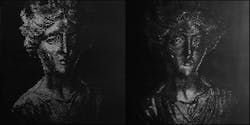SIGGRAPH: Images printed on 'reflectance paper' reflect light like 3D objects
Santa Cruz, CA--A printing method that combines so-called "reflectance paper" with conventional printing techniques enables printed objects and scenes to appear as if they were actually illuminated in 3D by the ambient light around the viewer. In other words, shine light from the left and the objects in the scene will appear as if light were hitting them from the left; move the light to the right and the lighting in the scene changes accordingly.
The technique, invented by researchers at the University of California, Santa Cruz,
, and 3M, is based on the reflectance paper itself, which contains a grid of reflective dimples, one per pixel. In printing, each pixel is partially covered by ink in a way that enables its reflectance to vary in the proper way as a function of angle. In this way, a flat grid of dimpled pixels produces an image that mimics being lit by the viewer's lighting conditions. The mimicking extends beyond specular reflection to Lambertian shading and interreflection among the objects in the scene.
Measuring the reflectance functions for an object or scene can be done by taking photographs lit from many different lighting directions. Art historians and restorers use such techniques for documenting important works of art and historical artifacts, says James Davis, an associate professor of computer science at UC Santa Cruz.
"Right now the quality of our prints is nowhere near what museums would need, but the basic idea of being able to capture all of that information in a print is absolutely of interest to them," Davis says. "It's not just a novelty. There are potential uses where people would want to take a picture and examine it later from different lighting angles."
The idea for the project emerged from a graduate course Davis was teaching, but he said it wouldn't have gone anywhere if he hadn't brought the idea to the HP researchers he was collaborating with on another project. The researchers at HP eventually teamed up with 3M to develop the reflectance paper. Two computer-science grad students at UC Santa Cruz wrote the software code for printing the reflectance functions. The team has published their results in a paper in ACM Transactions on Graphics and gave a presentation on August 6 at SIGGRAPH 2012 (Los Angeles, CA; Aug. 5-9, 2012).
Additional information, including images and video, can be found on the project website at graphics.soe.ucsc.edu/prf.

John Wallace | Senior Technical Editor (1998-2022)
John Wallace was with Laser Focus World for nearly 25 years, retiring in late June 2022. He obtained a bachelor's degree in mechanical engineering and physics at Rutgers University and a master's in optical engineering at the University of Rochester. Before becoming an editor, John worked as an engineer at RCA, Exxon, Eastman Kodak, and GCA Corporation.
